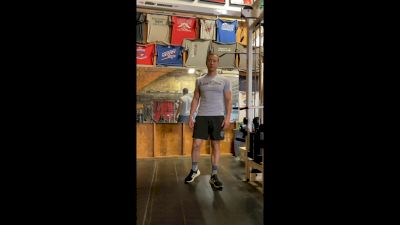Coach Myers Wrestling S&C: Using Cables To Build Wrestling Strength
Coach Myers Wrestling S&C: Using Cables To Build Wrestling Strength
I'm not usually a fan of machines for wrestling training, but there are some helpful ways you can use cables if that's what you need to use.

Unlock this article, live events, and more with a subscription!
Already a subscriber? Log In
I’ll just say this up front: I’m not a big fan of machines as a strength training modality. Most of my programming for athletes revolves around free weights (barbells, dumbbells) and functional pieces like sleds, ropes, and medicine balls.
However, that doesn’t mean that you can’t use common gym equipment such as cable machines to build strength for wrestling; the key is picking the right movements and integrating them with your big compound lifts.
Here are five of my favorite cable exercises that I use regularly with my wrestlers:
Straight Arm Lat Pull Downs (Single Arm)
Technique
Grab a cable attachment (or a band) with a single overhand grip. Drop down slightly into a split leg wrestling stance. Keeping your elbow slightly bent but locked as you pull the handle down towards your hips. Squeeze your lat and push your chest forward, holding for 1-3 seconds at the bottom.
Why you should do it
Everyone knows that strong lats are a necessity for wrestling, but this is one of the only exercises that isolates the lats without using the biceps for assistance (such as pull-ups or traditional pull-downs, for example). Position-wise, this exercise correlates strongly to the collar tie. Get strong on this exercise and snap your opponent down to the mat with ease.
How you should do it
Heavy sets of 3-5 reps per side as a stand-alone exercise or sets of 8-10 reps interspersed with “pushing” movements.
Straight Arm Lat Pull Downs
Technique
Grab a cable attachment with a shoulder-width or wide overhand grip. Stand up tall with your back arched but hips back slightly. Keeping your elbow slightly bent but locked as you pull the handle down towards your hips. Squeeze your lat and push your chest forward, holding for 1-3 seconds at the bottom.
Why you should do it
Same benefits as the single-arm variation.
How you should do it
Heavy sets of 3-5 reps per side as a stand-alone exercise or sets of 8-10 reps interspersed with “pushing” movements.
Cable Pull-Through
Technique
Face away from a low cable with a tricep rope or start attached. Hinge at the waist, then extend the hips forcefully, pulling the cable through your legs.
Why you should do it
Strong glutes and adequate hip extension is crucial to wrestling and also many of the strength movements we use — deadlifts, lunges, etc. You know that old saying about “too much of a good thing”? It doesn’t apply here; you literally cannot train your glutes and posterior chain enough.
How you should do it
Use this one as a warmup/activation (sets of 10-15) before heavy lower body movements, as a finisher or general prehab (higher rep sets for 100 total).
Face Pulls
Technique
Grab the tricep rope or start with an overhand grip. Pull the cable towards your face with your elbows up. Allow slight external rotation as you pause briefly to contract the upper back and rear delts.
Why you should do it
Shoulder health is a priority for all athletes, and the more work you can do for the posterior shoulder, the less chance you have of injury or strength imbalances popping up from doing heavy bench press or other pushing movements.
How you should do it
Moderate weight for sets of 10-20 reps. I try to work in 3-5 sets EVERY workout as active recovery between bigger movements.
Weighted Cable Crunch
Technique
Grab the tricep rope and kneel down facing away from the machine with the cable directly overhead. Crunch forward, keeping your hips upright and bringing your elbows towards the middle of your thighs. Keep your hips stationary.
Why you should do it
Although most core movements I use for wrestlers involve either stability or anti-rotational strength, it is important to work some abdominal flexion as well. Traditional crunches may burn, but those high rep sets do little to build actual core strength. This weighted crunch variation solves that dilemma.
How you should do it
Use heavy weight for sets of 10-15. I like to contrast this with an exercise for the lower back such as reverse hyperextension to target the anterior and posterior core muscles in one superset.
Coach Myers is the strength coach for the Ohio Regional Training Center at The Ohio State University. With the Ohio RTC since 2012, he served as Ohio State Wrestling’s primary strength coach from 2014-18, helping the Buckeyes win three Big Ten titles, their first-ever team NCAA championship, and two runner-up finishes.
A certified strength and conditioning specialist (CSCS), Coach Myers owns the Old School Gym in Pataskala, OH, and is a founding partner of top supplement company Max Effort Muscle. Follow him on Instagram and Facebook, and learn more about his strength and conditioning programs for wrestlers of all ages here.